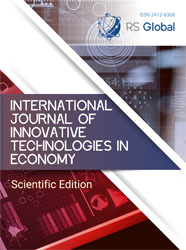COPYWRITING IN SOCIAL MEDIA
Abstract
The article discusses the role of copywriting in social media, both at the Georgian and international levels. After the spread of the COVID-19 pandemic, the attention of almost all countries of the world, including Georgia, was focused on using social media and especially copywriting for business development. The objective of the study is to study the problems of Highlighting the role of copywriting for successful business operations and to develop recommendations for its active use. The methods of material collection and analysis were used in the development of the paper. The method of data collection is mainly used in worldwide statistical data regarding the use of social media, on the basis of which the possibilities of using copywriting in successful business management were identified, the ways of their implementation were analyzed and outlined. In Georgia, as well as in other countries of the world, where the level of use of copywriting in business is less, it is important to raise the awareness of copywriting; To provide the public with correct and reliable information not only about the essence of copywriting, also about the need for its use in business. In Georgia for use copywriting in business, it is necessary to: Business representatives to share the experience of developed countries through social media and copywriting in terms of business; To create training-practical courses, which will teach the interested person not only the theoretical material about copywriting, but also it is practical application, this is important for training a qualified copywriter; To subsidize the free study of such courses, which ensure the formation of qualified copywriters, by means of sharing the experience of foreign specialists.
References
Agustiningsih, G. (2021). Application of Copywriting Elements in Social Media Advertising Drinking Products Now in Creating Consumer Interest. Jurnal Komunikasi dan Bisnis, 9(1), 55-67
Akhter, R. (2018). Impact of copywriting in marketing communication.
Albrighton, T. (2013). The abc of copywriting. United kingdom: Norwich. https://www.abccopywriting.com/wp-content/uploads/2013/04/The-ABC-of-Copywriting.pdf
Applegate, E. (2005). Strategic copywriting: How to create effective advertising. Rowman & Littlefield.
Blynova, N., & Kyrylova, O. (2018). Copywriting as an activity of online content creation. Communications and Communicative Technologies, (18), 13-21.
Ceci, L. (2022). E-mail usage in the United States - Statistics & Facts. Statista. https://www.statista.com/topics/4295/e-mail-usage-in-the-united-states/#dossierKeyfigures
Slobodianyk, A., Mohylevska, O., Salkova, I., & Abuselidze, G. (2022). Methods of Analysis of Commercial Activity and Marketing Pricing Policy at Processing Enterprises in Ukraine. International Scientific and Practical Conference Current trends in the development of modern scientific thought (pp. 196-201).
Sheriff, N. M., Zulkifli, A. S., & Othman, W. N. S. W. (2018). Salient features of customer engagement, visual presentation and copywriting for effective social media marketing: an exploratory perspective. Journal of Academia, 6(2), 28-37
Guo, X., Zeng, Q., Jiang, M., Xiao, Y., Long, B., & Wu, L. (2022). Automatic Controllable Product Copywriting for E-Commerce. In Proceedings of the 28th ACM SIGKDD Conference on Knowledge Discovery and Data Mining (pp. 2946-2956)
We are social/marketing and advertising company/statistics for social media. (2021). https://wearesocial.com/blog/2021/04/60-percent-of-the-worlds-population-is-now-online/
Pew research center/research centre/statistics for social media. (2021). https://www.pewresearch.org/internet/fact-sheet/social-media/
Galt & Taggart/research center/ Electronic commerce in Georgia. (2021). https://api.galtandtaggart.com/sites/default/files/2021-07/report/e-commerce-in-georgia_july-2021_geo.pdf
Views:
3673
Downloads:
2456
Copyright (c) 2022 Tamila Kartsivadze

This work is licensed under a Creative Commons Attribution 4.0 International License.
All articles are published in open-access and licensed under a Creative Commons Attribution 4.0 International License (CC BY 4.0). Hence, authors retain copyright to the content of the articles.
CC BY 4.0 License allows content to be copied, adapted, displayed, distributed, re-published or otherwise re-used for any purpose including for adaptation and commercial use provided the content is attributed.











